Diptera.info :: Identification queries :: Other insects, spiders, etc.
Who is here? 1 guest(s)
Page 1 of 2: 12
|
|
Scorpionfly: Panorpa germanica?
|
|
| nick upton |
Posted on 02-01-2011 00:25
|
|
Member Location: Wiltshire, UK Posts: 828 Joined: 12.03.10 |
Can anyone confirm my tenative ID of this male Panorpa. Thanks to some sketches on Tim Workfolk's excellent blog http://thetopshamnaturalist.blogspot.com I THINK the hypovalves fit this species better than the other possibles. Maybe too wide and flared to be P. commnunis, and it seems P germanica is the commonest in southwest of the UK. 9th June 2010 Wiltshire garden, UK c 15mm nick upton attached the following image: 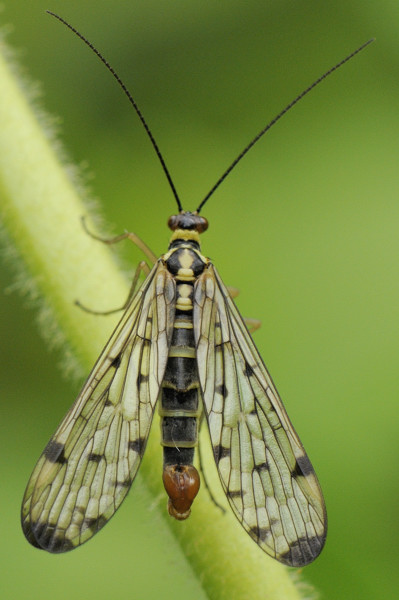 [110.76Kb] Nick Upton - naturalist and photographer |
|
|
|
| nick upton |
Posted on 02-01-2011 00:26
|
|
Member Location: Wiltshire, UK Posts: 828 Joined: 12.03.10 |
Close up of "sting" with hypovalves,
nick upton attached the following image: 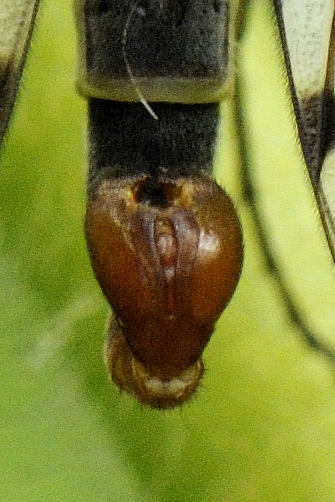 [189.6Kb] Nick Upton - naturalist and photographer |
|
|
|
| nick upton |
Posted on 02-01-2011 00:28
|
|
Member Location: Wiltshire, UK Posts: 828 Joined: 12.03.10 |
Another individual, same species?
nick upton attached the following image: 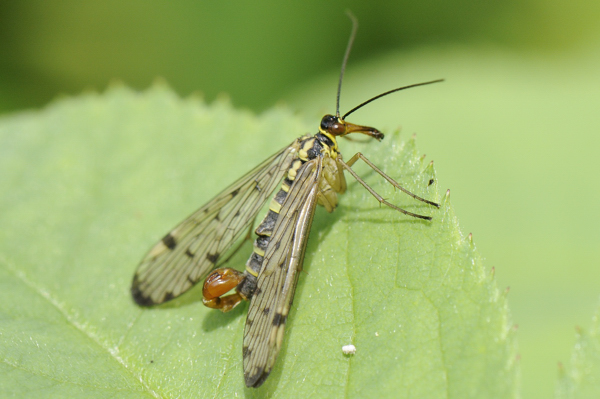 [179.93Kb] Nick Upton - naturalist and photographer |
|
|
|
| nick upton |
Posted on 02-01-2011 00:28
|
|
Member Location: Wiltshire, UK Posts: 828 Joined: 12.03.10 |
Close up of business end..
nick upton attached the following image: 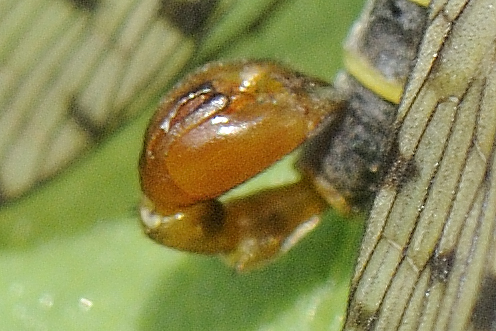 [185.7Kb] Nick Upton - naturalist and photographer |
|
|
|
| blowave |
Posted on 02-01-2011 01:06
|
|
Member Location: LINCOLN, UK Posts: 3151 Joined: 27.06.07 |
Yes that is P. germanica, you might find Arp's photos useful. They show the other factors to look for. I have all three species in my garden! http://www.wildab...photo/8541 Janet http://cubits.org... |
| ChrisR |
Posted on 02-01-2011 01:56
|
|
Super Administrator Location: Reading, England Posts: 7706 Joined: 12.07.04 |
Yes, that looks like the P.germanica I have seen around here (Berks & south Oxon) - the genitalia match (swollen tips) and the wing markings are usually smaller and browner than P.communis.  P.communis is usually the easier to work out because they are usually bigger and the wing markings are usually bolder and blacker ... but P.germanica and P.cognata are virtually impossible to split without male genitalia, IMO. I have all 3 species in my area - P.communis is the commonest, then P.germanica, then P.cognata. Manager of the UK Species Inventory in the Angela Marmont Centre for UK Biodiversity at the Natural History Museum, London. |
| Juergen Peters |
Posted on 02-01-2011 03:02
|
|
Member Location: northwest Germany Posts: 14348 Joined: 11.09.04 |
Hi, Chris! ChrisR wrote: P.germanica[/i] and P.cognata are virtually impossible to split without male genitalia, IMO. No reliable character, but normally P. cognata has a much lighter (red) head colouration here (and is much rarer than germanica). We had several discussions about Panorpa identification in my forum - but in German, so I think, posting links would be of no use here. I have all 3 species in my area - P.communis is the commonest, then P.germanica, then P.cognata. Don't you have vulgaris (distinguishable from communis by basal wing spot extending over two veins), alpina (which is by no means an alpine species; it occurs over whole of Germany) and hybrida? Except hybrida, which I have not found, yet, they all live here around my home in northwest Germany. Most abundant are P. communis and germanica, then vulgaris. The two others I only found occasionally. Best regards, Jürgen -=-=-=-=-=-=-=-=-=-=-=-=-=-=-=-= Juergen Peters Borgholzhausen, Germany WWW: http://insektenfo... -=-=-=-=-=-=-=-=-=-=-=-=-=-=-=-= |
| ChrisR |
Posted on 02-01-2011 11:18
|
|
Super Administrator Location: Reading, England Posts: 7706 Joined: 12.07.04 |
That's interesting - is there a key for identifying Panorpa spp. that works across Europe? I have a pair from Russia that looks like P.communis but I only have the British key figures 
Manager of the UK Species Inventory in the Angela Marmont Centre for UK Biodiversity at the Natural History Museum, London. |
| nick upton |
Posted on 02-01-2011 20:28
|
|
Member Location: Wiltshire, UK Posts: 828 Joined: 12.03.10 |
Many thanks Janet for the swift and good feedback, that photo link was really helpful. I only have a few definitive shots, but all my Wiltshire males are P. germanica so far. Tim Worfolk finds germanica the most common by far in Devon, followed by communis, but he hasn't seen cognata yet. Interesting to hear that you have all 3 in Lincs and that the ratios differ near Chris in Reading. At least we only have 3 to work out, unlike Juergen in Germany. They're great looking insects to photograph, tho a bit frustrating as they prefer the shadows, often lurking deep in bushes, and keep hopping off just as you hit focus on them.. One hung around the same part of the same bush for days and I finally got some decent shots of him!
Nick Upton - naturalist and photographer |
|
|
|
| blowave |
Posted on 02-01-2011 22:41
|
|
Member Location: LINCOLN, UK Posts: 3151 Joined: 27.06.07 |
Nick, I have a lot of shady areas in my garden and I spend a lot of time out there in any sort of reasonable weather looking. They tended to visit one area most, at times yes they would shoot off and other times they sat around for ages. I had two P. cognata males near each other, one disappeared fairly quickly but I got a shot or two. The other stayed forever, I left it in the end! They are much smaller than the other two species. I also got pics in 2009 I think of a female laying eggs in my 'lawn' but I'm not sure which species! She took no notice of me as I kneeled near her taking pics. I have some pics of a female P. cognata, they are easily recognised because of the red head but also they are much smaller and the wing patterns are usually quite faint by comparison. I think they became used to me being around, it seemed to become easier to get pics of them but they were often in awkard positions. I got a mating pair which was not in a good position, I had to shove in amongst the shrubs but they were not deterred. I got the male afterwards on his own, flexing his male parts.  I'm not sure which they were until I check and they are all still in my folders which I'm sorting but I found the female cognata. I'm not sure which they were until I check and they are all still in my folders which I'm sorting but I found the female cognata.
http://cubits.org... |
| Juergen Peters |
Posted on 03-01-2011 04:48
|
|
Member Location: northwest Germany Posts: 14348 Joined: 11.09.04 |
Hi, Chris! ChrisR wrote: is there a key for identifying Panorpa spp. that works across Europe? I'm afraid I don't know. As I mentionionedm we had many Panorpa discussions in our forum. They are in german, but Arp also posts many international links there. Perhaps you may find a key in one of them. http://insektenfo...adid=10388 http://insektenfo...#post79004 http://insektenfo...adid=16115 Edited by Juergen Peters on 03-01-2011 04:49 Best regards, Jürgen -=-=-=-=-=-=-=-=-=-=-=-=-=-=-=-= Juergen Peters Borgholzhausen, Germany WWW: http://insektenfo... -=-=-=-=-=-=-=-=-=-=-=-=-=-=-=-= |
| Juergen Peters |
Posted on 03-01-2011 04:55
|
|
Member Location: northwest Germany Posts: 14348 Joined: 11.09.04 |
Hi, Nick! Nick Upton wrote: Tim Worfolk finds germanica the most common by far in Devon, followed by communis That also differs by season. To my experience P. germanica is the earliest species in spring (2-3 weeks earlier than communis) and very numerous from late April to late May/early June. Later P. communis becomes more abundant and is - over the whole season - the most numerous species. Best regards, Jürgen -=-=-=-=-=-=-=-=-=-=-=-=-=-=-=-= Juergen Peters Borgholzhausen, Germany WWW: http://insektenfo... -=-=-=-=-=-=-=-=-=-=-=-=-=-=-=-= |
| ChrisR |
Posted on 03-01-2011 11:14
|
|
Super Administrator Location: Reading, England Posts: 7706 Joined: 12.07.04 |
Juergen Peters wrote: Hi, Chris! ChrisR wrote: is there a key for identifying Panorpa spp. that works across Europe? I'm afraid I don't know. As I mentionionedm we had many Panorpa discussions in our forum. They are in german, but Arp also posts many international links there. Perhaps you may find a key in one of them. http://insektenfo...adid=10388 http://insektenfo...#post79004 http://insektenfo...adid=16115 Thanks Juergen - I have had a look - quite interesting  I'm not sure how comprehensive Eckart's 'key' is ... would be nice to see a comparison of all the male genitalia, if they really are different ... but I will keep looking I'm not sure how comprehensive Eckart's 'key' is ... would be nice to see a comparison of all the male genitalia, if they really are different ... but I will keep looking 
Manager of the UK Species Inventory in the Angela Marmont Centre for UK Biodiversity at the Natural History Museum, London. |
| nick upton |
Posted on 03-01-2011 12:55
|
|
Member Location: Wiltshire, UK Posts: 828 Joined: 12.03.10 |
Many thanks Janet for describing your scorpionfly stalking exploits! I think I'll try to spend more time watching them this year as well, and will be more alert to which species I may be seeing (and when - thanks Juergen) and maybe where. I'd be very interested to see their weird courtship behaviour, involving pheromones, spitball gifts for females and courtship gifts too (see http://www.evolution.uni-bonn.de/PDF_Dateien/Engqvist%20&%20Sauer%20Ethology%202003.pdf). I was involved in filming the related hanging fly Hylobittacus (Mecoptera: Bittacidae) many years ago in the US, in which the male grabs small insect prey with grasping back feet, then emits pheromones and offers the gift to approaching females. I did have some good success photographing somewhat similar behaviour in Empids (Empis opaca)last year http://www.diptera.info/forum/viewthread.php?thread_id=30071, with dense clusters of males busy catching aerial prey (mostly bibionids) and then pairing up with females in flight before hanging on grass stems to mate. I'm more of a behaviourist than a taxonomist so get more interested and spend more time watching when stuff is happening!
Nick Upton - naturalist and photographer |
|
|
|
| blowave |
Posted on 03-01-2011 17:11
|
|
Member Location: LINCOLN, UK Posts: 3151 Joined: 27.06.07 |
would be nice to see a comparison of all the male genitalia, if they really are different ... but I will keep looking  Chris, you must have missed the link I put in my first post showing Arp's pics of male genitalia of the species we have here, as well as other features to look for. He used to post on WAB but now he can be found on WATW. http://www.wildab...photo/8541 I had a thread there in 2009 when I was trying to get to grips with these, I'm not sure if I saw P. cognata that year but I certainly did have it in 2010. I think it was later than the other species when I saw it, and got good pics to show the vital ID points. You might gain some tips from reading Arps input there, also in bonitin's thread. http://www.wildab...emale.html http://www.wildab...l#post8686 Nick, I didn't see any courtship behaviour other than the female munching on a fly as they were already mating when I found them! I have put pics on my site if you search for Panorpa there you should be able to find them all. http://cubits.org... |
| ChrisR |
Posted on 03-01-2011 17:33
|
|
Super Administrator Location: Reading, England Posts: 7706 Joined: 12.07.04 |
blowave wrote: would be nice to see a comparison of all the male genitalia, if they really are different ... but I will keep looking  Chris, you must have missed the link I put in my first post showing Arp's pics of male genitalia of the species we have here, as well as other features to look for. He used to post on WAB but now he can be found on WATW. http://www.wildab...photo/8541 Thanks Janet - yes I had seen that link but I am happy with the British species anyway ... I was just interested to see some of the European species because I have this pair of Russian Panorpa cf. communis. A member here has sent me some interesting European keys so I should be OK but it would still be nice to see if we can add P.vulgaris to the British list ... assuming someone hasn't published and not updated FaunaEuropaea 
Manager of the UK Species Inventory in the Angela Marmont Centre for UK Biodiversity at the Natural History Museum, London. |
| blowave |
Posted on 03-01-2011 19:45
|
|
Member Location: LINCOLN, UK Posts: 3151 Joined: 27.06.07 |
Chris, Arp certainly thought there was a possibility we have P. vulgaris here. Unfortunately the male genital bulb is not distinguishable from P. communis. The basal dark spot covering two cells could be a clue, I will have to refresh my memory but I think there is a clue depending on whether it completely covers the two cells or only partly. I had a very unusual female which had dark markings up the edges of the wings from the bottom, I really should have a closer look sometime at the pointers and see what I come up with. Of course I know a specimen is needed for any possibles.  I don't know which key you have, there's a French one here which could maybe be translated if the URL is copied and pasted into a google search. http://cubits.org... |
| ChrisR |
Posted on 03-01-2011 21:42
|
|
Super Administrator Location: Reading, England Posts: 7706 Joined: 12.07.04 |
I certainly wouldn't like to rely on wing markings for Panorpa ... they are variable enough in a number of species, so it doesn't look like it is a stable enough character. I prefer the genitalia differences (parameres?) but there are intermediates. At least with the genitalia you might get one that is clearly P.vulgaris, in amongst the ones that are intermediate.
Manager of the UK Species Inventory in the Angela Marmont Centre for UK Biodiversity at the Natural History Museum, London. |
| blowave |
Posted on 03-01-2011 22:07
|
|
Member Location: LINCOLN, UK Posts: 3151 Joined: 27.06.07 |
For female germanica & communis it is risky, but there is one feature which can be generally relied on if you can see it that is the number of veins in the radial ribs although there are some exceptions with communis which has 4, germanica has 3. I checked ny female with the dark edges, it has 3 and the general pattern speaks of germanica. Here's the translated key.. http://translate....d%3Divnsfd It would be the parameres to separate males of communis and vulgaris, but as there are variables that is not always conclusive. http://cubits.org... |
| nick upton |
Posted on 03-01-2011 22:31
|
|
Member Location: Wiltshire, UK Posts: 828 Joined: 12.03.10 |
Wow, you really have spent time stalking these critters Janet.... so many pics and some great feeding/mating views on your blog. I guess you turned up too late to see the courtship rituals, but maybe next year... Here's one of my females, which I'm naively assuming is P germanica as well, as amy males were P.germanica, and it looks like your pics of them. I've generally read that females can't be IDd, but you seem to have tried harder than most to do this. What do you think?
nick upton attached the following image: 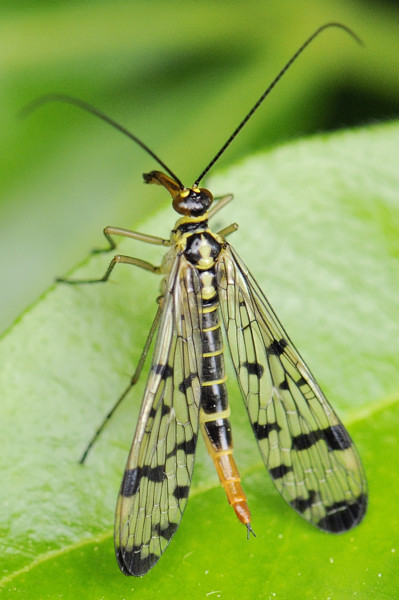 [128.76Kb] Nick Upton - naturalist and photographer |
|
|
|
Page 1 of 2: 12
| Jump to Forum: |













